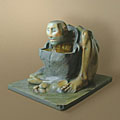Menú
Algunos dossiers
Juan Carlos
Distéfano
Distéfano
by
Adriana Lauria and Enrique Llambías
January 2003
January 2003
The dossier on Juan Carlos Distéfano spans from the time of his beginnings
as a painter to his recent works as a sculptor, a first for the CVAA. It covers
over forty years of his work and his commitment to art and reality. A special section offers a view on his work as a graphic designer, which he carried out mostly at the Di Tella Institute.
as a painter to his recent works as a sculptor, a first for the CVAA. It covers
over forty years of his work and his commitment to art and reality. A special section offers a view on his work as a graphic designer, which he carried out mostly at the Di Tella Institute.
In spite of all that
by Elba Pérez, exclusive to CVAA
by Elba Pérez, exclusive to CVAA
A small output of always renewed originality, Juan Carlos Distéfano’s work only took nine shows –spanning three decades– to position him in a unique place in Argentine art. He was born in bad times that became chronic in the country; his work is the ethical flipside of the infamous decade of the nineteen seventies. His sculptures reflect and bear witness to a long period of helplessness and incessant misery, only conceivable –and conceived by him– on an inhospitable land, under the Southern Cross.
In spite – or perhaps because – of that Distéfano’s work marks a sharp before and after in Argentine art. One should think its meaning would become globalized under more propitious circumstances. Distéfano shares this kind of erratic fate with Aldo Paparella, Emilio Renart, Alberto Heredia, and Norberto Gómez. Like them, he belongs to a group of creators of images, poetics and techniques united by passionate thinking – the kind which does not recoil before the heart of darkness or the brutal reality of Cain’s times. And it is no coincidence that matter and polychromy are central in this process that speaks to us of loss, of the defeat of reason and the will, and of maintaining human dignity in spite of it all.
With detritus reminiscent of a shipwreck, with bits of wood, Paparella constructed a spectre-like sleepwalker whom he dressed, like any shadow, in white. He invoked the ancient river gods that, many years later, would cast
more
















